If you are here, odds are that you had some good limoncello, maybe in one trip to Italy, and you are wondering how to make limoncello at home! I have some good news for you: while many typical Italian dishes are not as easy as they seem (e.g. making a Neapolitan pizza at home), preparing homemade limoncello with grain alcohol is definitely easy!
What you need for limoncello
So, let’s start sharing my limoncello recipe. To make your own limoncello you don’t need any particular skill or equipment, since it is not a distilled liquor. You only need to infuse lemon peels into grain alcohol, which is the best alcohol for limoncello! Yes, this is the only authentic way to prepare limoncello: no vodka, no other distilled liquors are used in Italy to make it.
What can vary, instead, is:
- the ratio between alcohol and (water + sugar): use more or less syrup if you prefer your lemoncello to be less or more strong. In the recipe below, I use 1 liter of water, 600 gr of sugar and 1 liter of alcohol. This will result in a limoncello with 37% in alcohol content. If you want a 29% limoncello, usually more appreciated by women, use 1.4 liter of water and 830 gr of sugar
- the ratio between water and sugar: use more or less sugar if you prefer your homemade limoncello more on the sweet side rather than tart and citrusy
- the duration of the infusion: you can leave the peels in the grain alcohol for at least 1 week, up to 1 month. To be honest, there is not a major difference and I usually leave them for about 10 days.
Which lemons to choose and one tip
Here in Italy, Amalfi Coast (Costiera Amalfitana) is the most famous area for limoncello. The reason is very simple: over there you can find the most amazing lemons of the whole country: big, with thick peel and great flavor.
Actually, other regions are very famous for limoncello: Sicily in Southern Italy, but also Lake Garda in Northern Italy, with its famous micro-climate.
What is really mandatory is that you choose organic lemons. This for at least two reasons:
- first, and most important, is that alcohol extracts every substance from the peels. When I say “every”, that will include pesticides and insecticides used to grow lemons in non-organic farming
- second reason is that non-organic lemons often come with a wax coat, that somehow prevents flavor to be released into the alcohol and ultimately into your limoncello.
Regarding the lemons, one tip is crucial. The peel is very rich in essential oils, and those are what you extract from them. But it’s very important that you avoid peeling the white part, since it is really bitter and will give you a bad flavor to your homemade limoncello with grain alcohol. That’s why I recommend using a vegetable peeler, since a simple knife would make this task really tough. As usual, if you want to support my effort into this blog, at no additional cost you can buy the one I recommend for this purpose.
But now, it’s time to answer your question how can I make limoncello at home and find out that the most famous Italian digestive is actually easier than you ever thought! And it is incredibly cheap as well, compared to the one you are used to buying. So that it can become a very appreciated gift idea for your friends! I do often and they really love that!
If you like this recipe, please PIN IT or subscribe to my newsletter (page bottom), thank you!
Homemade limoncello with grain alcohol
Equipment
- a vegetable peeler
- a sealed glass container
- a pot
- a spoon
- a strainer
- a funnel
Ingredients
- 5 organic lemons
- 500 ml grain alcohol
- 300 gr sugar
- 500 ml water
Instructions
- Start washing accurately the lemons and drying them with a towel.

- Using a vegetable peeler, peel the lemons. It's very important that you don't remove the white part of the peels, you need only the yellow one.

- Put the peels into a sealed glass container (I use a jar) and cover them with alcohol. Seal the container and put it in a fresh and dark place.
- I move the container every day to mix the ingredients, for at least one week, usually for 10 days. You will see every day the peels loose color and the liquid become more intensly .yellow.

- After the resting period, prepare the syrup. Warm the water in a pot and make the sugar melt in it, gently mixing. When the syrup is ready, let it cool down.

- Add the syrup to the alcohol and the peels and mix it.

- With a funnel, strain the liquid into the bottles in which you will store the limoncello.

- Let the limoncello rest for a couple of weeks, then store the bottles in the fridge. To be served really cold. Enjoy!

Limoncello is amazing, and you can even use it to create a limoncello spritz! Just use limoncello, soda, and prosecco in equal ratios.
And if you like to try yourself at homemade liquors, you should make my amazing rucolino , which you will find only in Ischia (Naples)… and my favorite one, the authentic nocino (walnut liquor)!
Disclosure
Some of the links above are affiliate links. This means that, at no additional cost to you, if you click through and make a purchase you will help this blog grow. I only promote affiliate programs that I believe in, and products I know about, with the aim to help you in your choices.
Buon appetito!

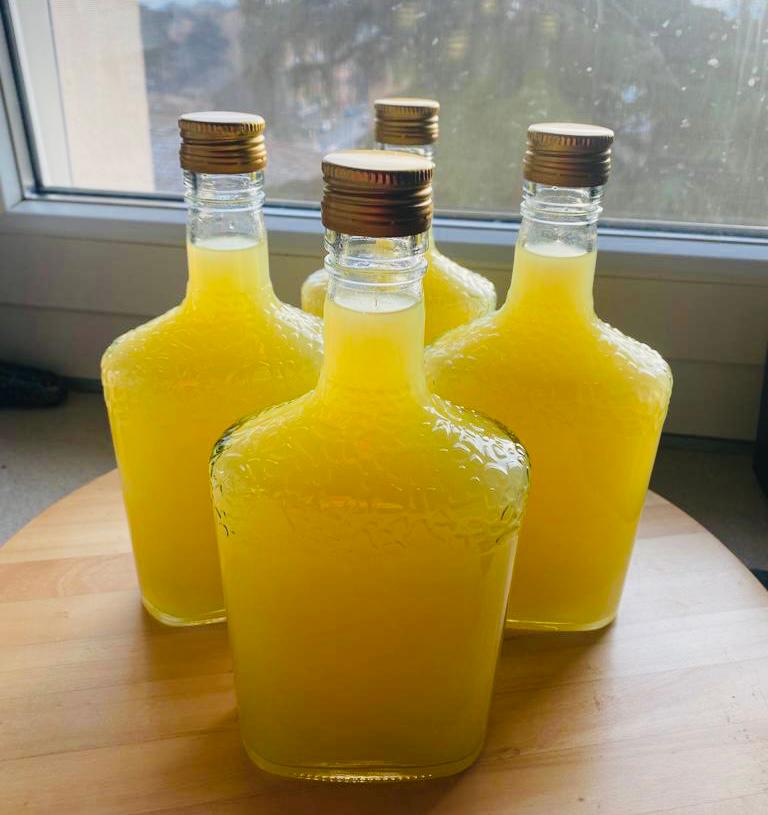
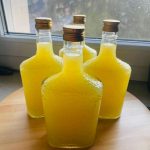
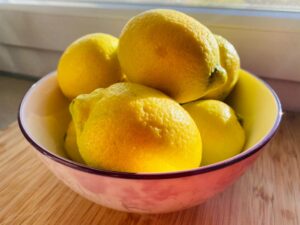
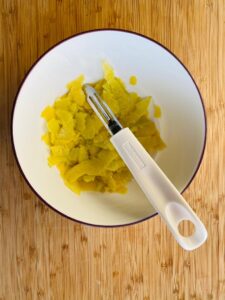
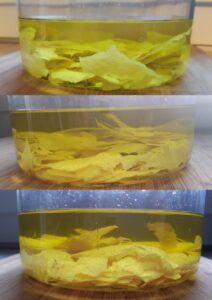
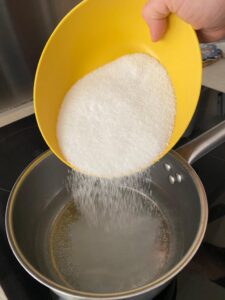
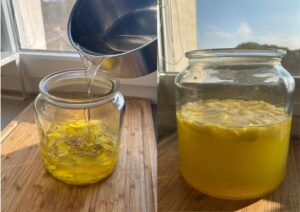
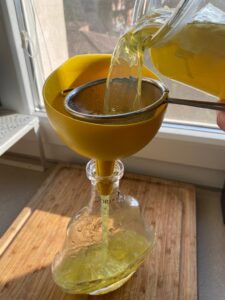
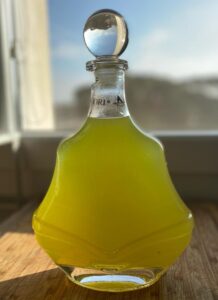
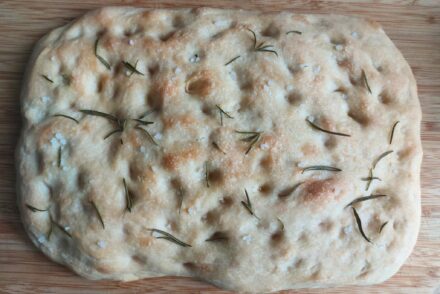
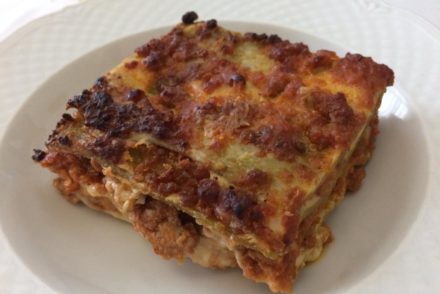
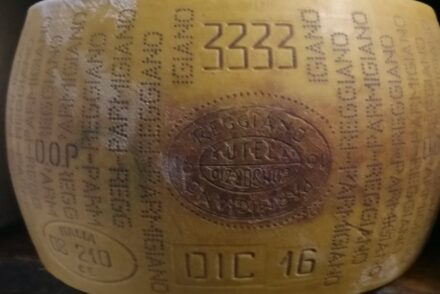
5 Comments
I planned to make a double batch and after peeling the zest and pouring the alcohol on it, I realized I had a 750ml bottle, not 1L
Is 10 lemons too much for 1-1/2x the recipe or should I buy more alcohol a day late?
I should also mention that the grain alcohol is 151 proof because of state law. Should I reduce the final water content as well or use more than 1L of alcohol?
not sure I understand what is “151 proof”. You mean it’s not pure alcohol? Here we have 96° alcohol…
Proof just means 2 times the alcohol percentage.
So 151 proof = 75.5%. You are using 192 proof. Many states in the U.S. do not allow that.
I decided to press on with the double recipe, but will use 1270 ml of the 75.5° grain alcohol and I’ll reduce the water later by 270ml.
I’ll also let the peels soak longer.
Do you have a recipe for Crema di Limoncello? I’ve been thinking of doing that with part of this batch but there is no consistency to the recipes online.
hi, it depends actually on lemons’ size, if they are small it’s definitely ok!